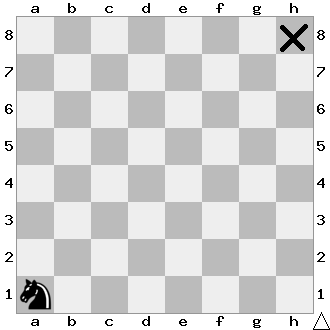Knight is might!
On an chessboard, can a knight move from one corner to the opposite corner, visiting each and every remaining square exactly once on its way there?
Clarification:
A knight can move to a square that is either two squares away horizontally and one square vertically, or two squares vertically and one square horizontally.
This section requires Javascript.
You are seeing this because something didn't load right. We suggest you, (a) try
refreshing the page, (b) enabling javascript if it is disabled on your browser and,
finally, (c)
loading the
non-javascript version of this page
. We're sorry about the hassle.

Relevant wiki: Coloring (Parity Arguments)
In one move we know that a knight moves from a black square to a white one or the other way around, which means that it alternates its colour after each move. So, we can conclude that after every 2 moves, that is, after an even number of moves, the knight ends up on the same colour that it started from. Now, if it must touch all 64 squares just once and end up at H8, then it will require 63 moves, which is an odd number. An odd number of moves will result in the knight ending up on a white square as it started on A1 (black).
But H8 is black.
So the knight can never ever reach H8, by going through each and every square.